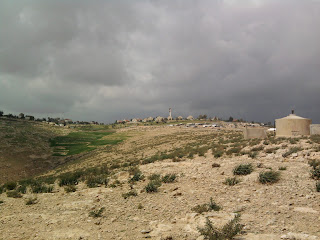My contact (I'll call him Hassan) took me to a meeting called by the Governor of Hebron Province. When demolition orders are issued the people concerned need to know what to do - ignoring it is fatal. And the first person they'd go to would be their community leader. So all the community leaders had been called so they'd know the tortuous process the Israelis use, and therefore be able to give the right advice. Slides were shown of a demolition order (which apparently is often purposely left under a rock or stone, so that it can be missed). Then there's the announcement in the paper (but written in such small tight script you could overlook it, even if you did buy the correct copy of the newspaper, which you probably wouldn't). The person receiving the order then needs to take it to the court; the meeting was given a list of legal firms which would do the work for free. It's all frighteningly efficient within the Israeli legal system.
Hassan has huge respect for the Governor who said at the end of the meeting that it was critical this information was available to everyone. He (the Governor) said he'd called the meeting for all community leaders, and unless those who'd failed to turn up had an acceptable excuse, he'd come down hard on them.
Hassan added that he couldn't bear to work in East Jerusalem where house demolitions are a daily occurrence. There the owner is fined for having an 'illegal' property and has the choice of either demolishing his/her own home or paying the costs of bulldozers, trucks, police etc, AND the cost of removing the rubble. So some people demolish their own homes rather than have this financial burden as well!






















